
Russia and Courtly Europe: Ritual and the Culture of Diplomacy, 1648–1725 PDF
Preview Russia and Courtly Europe: Ritual and the Culture of Diplomacy, 1648–1725
Russia and Courtly Europe Inthisnewbookonearlymoderndiplomacy,JanHenningsexploresthe relationshipbetweenEuropeanpowersandRussiabeyondtheconven- tional East–West divide from the Peace of Westphalia to the reign of PetertheGreat.Heexamineshow,atamomentofnewdeparturesin both Europe and Russia, the norms shaping diplomatic practice emerged from the complex relations and direct encounters within the worldofprincelycourtsratherthanfromincompatiblepoliticalcultures. Hemakescleartheconnectionsbetweendynasticrepresentation,poli- tics,andforeignrelationsandshowsthatRussia,despiteitsperceived isolationandculturaldistinctiveness,participatedinthedevelopments andtransformationsthatweretakingplacemorebroadlyindiplomacy. Thecentralthemesofthisstudyaretheinterlockingmanifestationsof socialhierarchy,monarchicalhonour,andsovereignstatusinbothtext andritual.Relatedissuesofdiplomaticcustoms,institutionalstructures, personnel,negotiation practice, internationallaw,and thequestion of culturaltransferalsofigureprominently. Jan Hennings is Assistant Professor of History at Central European University,Budapest. NewStudiesinEuropeanHistory Editedby PETERBALDWIN,UniversityofCalifornia,LosAngeles CHRISTOPHERCLARK,UniversityofCambridge JAMESB.COLLINS,GeorgetownUniversity MIARODRÍGUEZ-SALGADO,LondonSchoolofEconomicsandPolitical Science LYNDALROPER,UniversityofOxford TIMOTHYSNYDER,YaleUniversity TheaimofthisseriesinearlymodernandmodernEuropeanhistoryistopublish outstanding works of research, addressed to important themes across a wide geographical range, from southern and central Europe, to Scandinavia and Russia,fromthetimeoftheRenaissancetothepresent.Asitdevelopstheseries willcomprisefocusedworksofwidecontextualrangeandintellectualambition. Afulllistoftitlespublishedintheseriescanbefoundat:www.cambridge.org/new studiesineuropeanhistory Russia and Courtly Europe Ritualand theCulture ofDiplomacy,1648–1725 Jan Hennings CentralEuropeanUniversity UniversityPrintingHouse,CambridgeCB28BS,UnitedKingdom CambridgeUniversityPressispartoftheUniversityofCambridge. ItfurtherstheUniversity’smissionbydisseminatingknowledgeinthepursuitof education,learning,andresearchatthehighestinternationallevelsofexcellence. www.cambridge.org Informationonthistitle:www.cambridge.org/9781107050594 ©JanHennings2016 Thispublicationisincopyright.Subjecttostatutoryexception andtotheprovisionsofrelevantcollectivelicensingagreements, noreproductionofanypartmaytakeplacewithoutthewritten permissionofCambridgeUniversityPress. Firstpublished2016 PrintedintheUnitedKingdombyClays,StIvesplc AcataloguerecordforthispublicationisavailablefromtheBritishLibrary. LibraryofCongressCataloging-in-PublicationData Hennings,Jan,author. RussiaandcourtlyEurope:ritualandthecultureofdiplomacy,1648–1725/Jan Hennings(UniversityofOxford). Cambridge : Cambridge University Press, 2016. | Series: New studies in Europeanhistory|Includesbibliographicalreferences. LCCN2016036669|ISBN9781107050594(hardback) LCSH: Europe – Foreign relations – Russia. | Russia – Foreign relations – Europe.|Diplomacy–History–17thcentury.|Diplomacy–History– 18thcentury.|Europe–Kingsandrulers–History.|Russia–Kingsandrulers– History.|Europe–Courtandcourtiers–History.|Russia–Courtand courtiers–History.|Politicalcustomsandrites–Europe–History.|Political customsandrites–Russia–History. LCCD34.R9H462016|DDC327.470409/032–dc23 LCrecordavailableathttps://lccn.loc.gov/2016036669 ISBN978-1-107-05059-4Hardback CambridgeUniversityPresshasnoresponsibilityforthepersistenceoraccuracyof URLsforexternalorthird-partyInternetWebsitesreferredtointhispublication anddoesnotguaranteethatanycontentonsuchWebsitesis,orwillremain, accurateorappropriate. Contents ListofIllustrations pagevii Acknowledgements ix NotesonTransliteration,Spelling,andDates xi ListofAbbreviations xii Introduction 1 GeometryofPower:CourtSocietyandDiplomacy 12 RitualandRecognition 15 ContemporaryDefinitionsofDiplomaticCeremonial 19 TheCourtandthePublic 22 1 BarbarousCeremonies?Russia’sPlacesinEarlyModern Diplomacy 25 Russia:ABlindSpotintheSystem? 25 DiscoursesofRussianBarbarism 35 CeremonialCounterpoints 44 CeremonialDiscourseandItsSources:WhoWeretheBarbarians? 63 2 FactsandFictions:TheOrganisationofDiplomatic Practice 69 TheAmbassadorialChancellery 69 Pristavy,IntroducteursdesAmbassadeurs,andMastersofCeremonies 77 CeremonyandtheWrittenWord 82 TheSovereign’sBreathandVoice:RepresentationandDiplomaticRanks 90 DifferencesandSimilarities 108 3 ThroughthePrismofRitual:Anglo-RussianEncounters intheSeventeenthCentury 112 Routine 112 TheEmbassiesofDokhturovandColepeper(1645–1649) 115 TheCommonwealth’sEmbassytoRussia(1655) 122 Prozorovskii’sEmbassy(1662/63) 127 ReadingbetweentheGesturesI:AlekseiMikhailovichvs.LouisXIV 131 Carlisle’sEmbassy(1663/64) 139 ReadingbetweentheGesturesII:PerceptionandDeception 154 v vi Contents 4 StageandAudience:TheGrandEmbassytoVienna (1698)andPeterI’sVisittoParis(1717) 160 Vienna1698 160 PublicCeremonies 167 Divertissements 171 PrivateMeetings 177 SecretNegotiations 182 Paris1717 187 5 FromInsulttoImperator:ChangesandContinuities intheReignofPeterI 202 Anti-ceremonialPeter? 202 CeremonyandReform 208 CeremonialKnowledge 215 PeterI’sHonourandtheBritishConstitution 220 Imperator 237 Empire 239 Conclusion 247 Bibliography 255 Index 292 Illustrations I.1 GeometriaandJustitiawatchingthesocialorder. FrontispiecetoJ.B.v.Rohr,Einleitungzur Ceremoniel-WissenschaftdergrossenHerren(Berlin,1733).URL: http://digital.bibliothek.uni-halle.de/hd/content/pageview/ 1116988.ReproducedbypermissionofUniversitäts-und LandesbibliothekSachsen-AnhaltinHalle(Saale). page13 1.1 PublicaudienceofAmbassadorPetrI.Potemkinat Versaillesin1681(BnF,EstampesetPhotographie, ReserveQB-201(59)-Fol-Hennin,5223).Reproduced bypermissionofBibliothèquenationaledeFrance. 37 2.1 PortraitsfromtheTsarskiitituliarnik(1672).Inorderof appearance:TsarAlekseiMikhailovich,KingLouisXIV,Holy RomanEmperorLeopoldI,ElectorofBrandenburgFrederick William(RGADA,f.135,otd.V,rubr.III,no.7,ll.50,118, 132,196).ReproducedbypermissionofRossiiskii gosudarstvennyiarkhivdrevnikhaktov. 73 3.1 TitlepagetoG.Miege,Arelationofthreeembassiesfrom HisSacredMajestieCharlesIItothegreatDukeofMuscovie, theKingofSweden,andtheKingofDenmark,performedbythe EarlofCarlisleintheyears1663and1664(London,1669). ReproducedbypermissionofHoughtonLibrary,Harvard University,andProQuest–EarlyEnglishBooksOnline. 155 3.2 Posol’skaiakniga,RussianaccountofCharlesII’s1663 embassytoMoscow(RGADA,f.35,op.1,d.11,ll.1,2). ReproducedbypermissionofRossiiskiigosudarstvennyi arkhivdrevnikhaktov. 155 4.1 Bird’s-eyeviewofPeterI’sGrandEmbassy’ssojournin Vienna(1698). 162 4.2 ReconstructionofthefloorplanoftheFavorita(firstfloor). E.Schlöss,BaugeschichtedesTheresianumsinWien(Vienna, 1998),p.58. 168 vii viii ListofIllustrations 4.3 Vienneseceremonialrecord:ThepublicaudienceofPeterI’s GrandEmbassyatthecourtoftheHolyRomanEmperor (HHStA,ZAProt,5,fol.431v).Reproducedbypermission ofHaus-Hof-undStaatsarchiv,Vienna. 170 4.4 Russianceremonialrecords:TheRussiansketchofthe GrandEmbassy’spublicaudience(RGADA,f.32, op.1,d.45,l.649ob).Reproducedbypermissionof Rossiiskiigosudarstvennyiarkhivdrevnikhaktov. 171 4.5 DepictionoftheWirtschaftfestivityheldintheFavoritain honourofPeterI’sGrandEmbassytoVienna.Historisch- PolitischerKalender(1698).PrintedinV.S.Moldavan, V.T.Pashuto,V.T.Moskva:illiustrirovannaiaistoriia, 2vols.(Moscow,1984–86),I,p.142. 173 4.6 ListoftheparticipantsoftheWirtschaft(HHStA,ZAProt, Bd.5,fol.439).ReproducedbypermissionofHaus-Hof-und Staatsarchiv,Vienna. 174 4.7 TheseatingplanatdinnerattheWirtschaft.TheatriEuropaei ContinuatiFunffzehenderTheil/Dasist:AbermaligeAußführliche FortsetzungDenck-undMerckwürdigsterGeschichten(Frankfurt a.M.,1707),p.474.ReproducedbypermissionofCambridge UniversityLibrary. 175 4.8 Vienneseceremonialrecords:Sketchofthegalleryinthe Favorita,depictingthepositionstakenbytheparticipants duringtheprivatemeetingbetweenPeterIandLeopold I(HHStA,ZAProt,5,fol.423).Reproducedbypermission ofHaus-Hof-undStaatsarchiv,Vienna. 179 5.1 DepictionofthepeacecelebrationsheldattheRussian ambassador’sresidenceinParisontheeventofthePeace ofNystad1721(AVPRI,f.93,op.93/1(1721),d.7,l.399). ReproducedbypermissionofArkhivvneshneipolitiki Rossiiskoiimperii. 207 Acknowledgements Russia and Courtly Europe started life as a doctoral project. I thank my supervisor at Clare College, Cambridge, Hubertus Jahn, and my co- supervisor at the University of Münster, Barbara Stollberg-Rilinger, for their continued support and intellectual guidance during and long after the PhD. I consider myself very lucky to have benefited from their combinedexpertiseofRussianandearlymodernhistory,acombination thatwascrucialforthewayinwhichthisbookhasevolved.Christopher Clarkand Simon Dixon haveaccompanied mywork fromthe vivavoce examinationatCambridgetotheearlystagesofthebookmanuscript,and Iamthankfulforboththeirdetailedcritiqueandencouragingfeedbackin the process of turning the dissertation into a monograph. I also thank CambridgeUniversityPress’threeanonymousreadersfortheirthorough andconstructiveassessmentsofthebookmanuscript.Aspecialdebtmust be paid to the Cottrell-Dormer family who kindly welcomed me at Rousham House and allowed me to use the manuscripts held in their privatearchive.Ialsowishtoacknowledgeandthankthemembersofstaff ofthearchivesandlibrariesthatIvisitedinMoscow(AVPRI,RGADA, RGB,andGPIB),Vienna(HHStAandÖNB),Paris(BnF,AN,BM,BA, and AAE), London (TNA and BL), Cambridge (Cambridge UL), Oxford (Bodleian Library), and Berlin (UB Humboldt-Universität and Staatsbibliothek).Thosewhohavecommentedonversionsofthisbookin its entirety, or on parts of it, will know how much I appreciate their criticism:IamgratefultothelateIsabeldeMadariaga,JereonDuindam, André Krischer, Hamish Scott, Ol’ga G. Ageeva, Judith Loades, Tony Lentin, Tracey Sowerby, William O’Reilly, Robyn D. Radway, Joachim Klein,Mark Hanin, Ambrogio Caiani, Eftychia Bathrellou,andmy col- leaguesatCentralEuropeanUniversity,CharlesShaw,AlexeiMiller,and AlfredJ.Rieber.Mygratitudealsoextendstothosewhohavegenerously sharedtheirknowledgewithmeandgivenvaluableadviceatvariousstages of mywork. Inparticular,I thankPetrI.Prudovskii,Tim Blanning,the late Lindsey Hughes, Nikolai M. Rogozhin, Aleksandr Lavrov, Lyndal Roper, Christian Windler, David Parrott, Andreas Pecˇar, Christina ix x Acknowledgements Brauner, Dmitri Gouzevitch, Andrei G. Tiul’pin, Reinhard Frötschner, ChristineRoll, Iskra Schwarcz, Jan Plamper, Frithjof BenjaminSchenk, Ingrid Schierle, Roland Cvetkovski, Till Hennings, Niels Fabian May, Christian Steppan, Henriette Korthals Altes, Yulia Karpova, Olaf Schmidt,AntjeGirndt,themembersoftheStudyGrouponEighteenth- Century Russia, the members of both the former Leibniz-Projekt ‘Vormoderne Verfahren’ and the Sonderforschungsbereich 496 at the University of Münster, and the members of the research network the ‘TextualAmbassador’forinsightfulconversationsaswellasforpractical support.IamindebtedtoClareCollegeforgrantingmetheG.R.Elton ScholarshipandtotheStudienstiftungdesdeutschenVolkes,theZEIT- StiftungEbelinundGerdBucerius,andtheKurtHahnTrustforsupport- ingmydoctoralstudies.AJuniorResearchFellowshipatStJohn’sCollege inOxfordprovidedthespaceformetogrow,completemyresearch,and revisethemanuscriptforpublication.IthankTaylor&FrancisGroupfor givingpermissiontoincludematerialsfrommyarticle,‘Thesemioticsof diplomatic dialogue: pomp and circumstance in Tsar Peter I’s visit to Vienna in 1698’, International History Review, 30 (2008), 515–44, in the Introduction and Chapter 4 of this book. Finally, I wish to express my deepgratitudetomyfamilyandmyfriends,andtoRobyn,withoutwhose supportthisbookcouldnothavebeenwritten.
